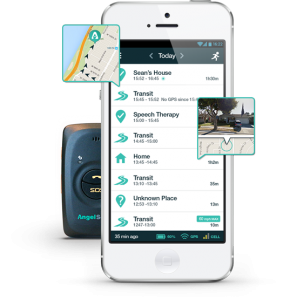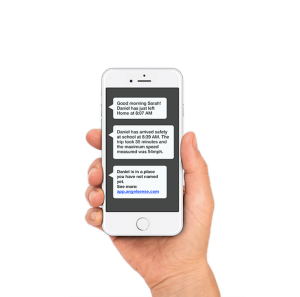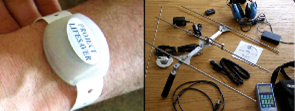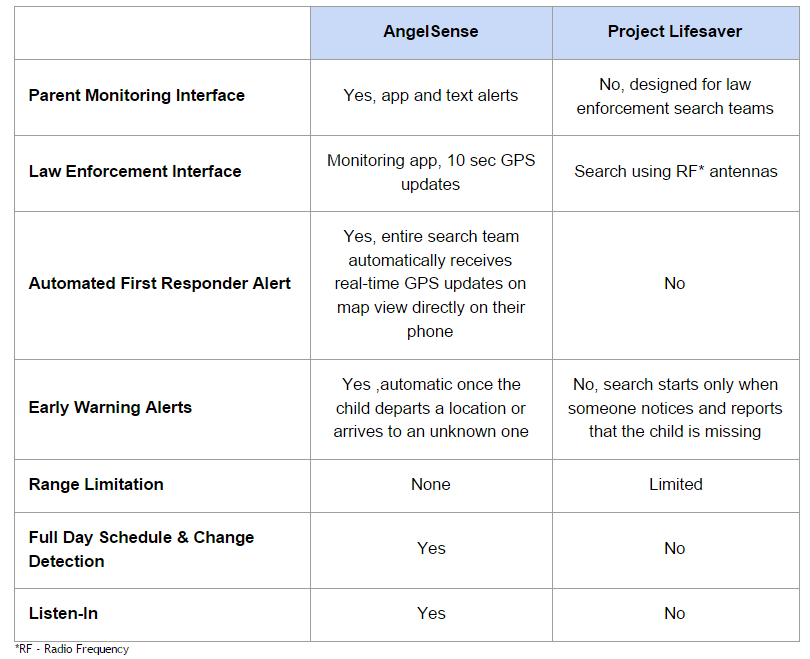What’s the Difference Between AngelSense and the Project Lifesaver program?
Updated on October 21, 2020A guest post by Natasha Cornin, an AngelSense GPS and Voice Monitoring Solution expert user and customer care specialist.
The AngelSense GPS tracking device can help you improve your child’s safety and well-being.
One of the most amazing things about our AngelSense community is the ongoing dialogue we share about what matters most to us for the benefit of safeguarding our children. As I interact with parents on our Facebook page I often hear inquiries related to the Project Lifesaver program and how it compares to the AngelSense GPS tracking device. Are the features comparable? How does each GPS device work and in which ways do they differ?
I composed the following article in response to some of these FAQs, to provide some clarity on the topic in an effort to empower parents of special needs children to make the best choice to meet their family’s needs.
AngelSense is the only monitoring solution designed for individuals with special needs. It includes a GPS device, advanced data analytics, and a smartphone app for all caregivers and first responders. AngelSense alerts as soon as the person leaves a safe zone, pinpoints the location on a map, and offers a wide range of search tools such as sharing the live location with first responders, speaking with the person using auto-pickup speakerphone, and activating a loud sound on the device.


Project Lifesaver is a radio-frequency technology based system (RF) used by law enforcement search teams to help in the search efforts of missing individuals. It involves attaching a radio transmitter device to the wrist or ankle of persons at-risk of wandering. The transmitter emits an inaudible pulse once per second that can be picked up by a hand-held directional antenna and the radio-tracking signal becomes stronger and louder as you get closer to the missing person. Once realizing the person is missing, caregivers contact the Search and Rescue (SAR) center and trained operators start the search by directing the antenna according to the audible sound, indicating the missing person’s direction. Typical effective range is not predictable, averaging at a few miles and special training is required to operate the equipment.

AngelSense alerts prevent most wandering incidents from developing into a major search. Search efforts end quickly as first responders and caregivers have access to the live GPS location and search tools. There are no range limitations and tracking can be done from any smartphone.
THE ANGELSENSE DIFFERENCE
Automatic alert as soon as the person leaves a safe zone
AngelSense sends an alert as soon as the person exits a safe zone. This prevents many wandering incidents from developing into a major search. A search with an RF system starts after caregivers realize the person is missing, conduct an initial search, and only then contact the SAR center to report a missing person. The SAR center then dispatches the RF system’s trained operator to start the search. This lengthy process increases the risk of injury or worse.
Live GPS location on a map for all search team members
AngelSense can be used by an unlimited number of people such as family, school staff, and SAR team members. Search efforts end quickly, as first responders and caregivers have access to the live GPS location and a broad set of search tools. This makes search efforts with AngelSense highly effective.
Talk to the missing person and people nearby with auto-pickup speakerphone
AngelSense provides a 2-Way voice capability with an auto-pickup speakerphone that was designed for individuals with special needs. The caregiver can call and instruct the missing person to stop or speak with people nearby. RF systems do not include any voice capabilities.
No range limitations, track from any smartphone, tablet or PC
AngelSense uses GPS technology that has no range limitation. As long as there is cellular connectivity, even a partial one, AngelSense will pinpoint the location on a map. It also offers many tools to locate a missing person indoors, such as activating a loud sound on the device and locating the person using Wi-Fi, or remotely listening to the person’s surroundings. RF technology search systems have an average range of a few miles, that is dependent on environmental factors and conditions.
Sensory friendly device, customized wearing accessories
AngelSense provides a wide variety of non-removable sensory friendly wearing options. These include a sleeve for wearing the device inside a pants pocket, a soft and tagless undershirt with a special pocket, and a waist belt that is worn on the body. All wearing accessories are secured by customized fasteners making it removable only with a magnetic key held by the parent or caregiver. The device is water resistant, and includes an optional waterproof pouch. RF systems include a bracelet. Children with special needs many times resist wearing the bracelet due to sensory sensitivity.
Charging and wearing reminders
To ensure daily use, AngelSense sends daily reminders to the primary caregivers, reminding them to charge the device at night and wear it in the morning.
RF bracelets typically have a longer battery life as they do not use cellular networks and GPS, and they don’t transmit GPS location data.
No special training or equipment needed for Search & Rescue teams
The AngelSense solution includes an intuitive app accessible from any internet connected smartphone, tablet or PC, very similar to a navigation app we all use daily.
Cost saving by preventing major search incidents
The AngelSense solution and search tools are mainly used by parents and caregivers who can react to the proactive alerts immediately. Therefore, most wandering incidents end in a few minutes and do not require contacting search and rescue teams.
The following is a comparison of the features offered by AngelSense vs. Project Lifesaver:
To Summarize
AngelSense GPS solution is based on modern mobile technology combined with innovative data analytics. AngelSense provides a cost-saving solution to public safety officials and the communities they serve.
With reliable proactive alerts, voice features and GPS live location sharing, AngelSense improves the ability to locate missing persons quickly, increases the efficiency of the search efforts, and in many cases prevents wandering incidents from occurring.


